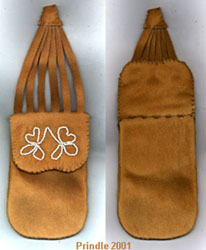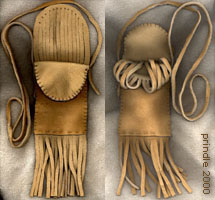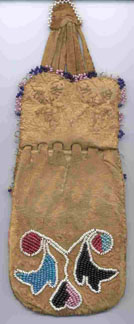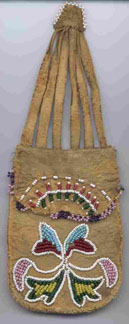
| Learning about Puzzle Pouches |
Potawatomi puzzle pouch. |

| Learning about Puzzle Pouches |
Potawatomi puzzle pouch. |
Learning about the puzzle pouch is a story in it's own. I'm indebted to several people in the creation of these pages. First, there is Ron Mayer who initially emailed me trying to find out more about the origin & construction of puzzle pouches. In a six minute documentary on TVOntario, Ron had seen these bags being made by Darren Lentz, a teacher at Pelican Falls First Nations High School in Sioux Lookout. Ron's sister teaches Ojibway children north of Red Lake and thought it would be a great project for her class. Myself, although vaguely familiar with the existence of this type of pouch, was completely unfamiliar with the construction or the history of this ingenious bag.
My curiosity became piqued and I was soon obsessed with how these puzzle pouches are made and who makes them. Ron also posted an inquiry on Suzanne Coopers Bead Board and received a reply from Brenda who had a pattern for the puzzle pouch. She kindly shared the pattern with Ron, who in turn shared them with me. From an inquiry (thank you ‘WoahNellie' for posting for me!) to the ‘Crafts Lodge' at Iroquois Viewpoints, one of the administrators, Sakoieta Tree, mentioned he has a Tyendinaga Mohawk friend who currently makes puzzle pouches. So far we've learned that puzzle pouches are now made by Mohawk and are sold in craft stores, but still we didn't know much about the Native American history or styles of this kind of bag.

I set to work, first making a paper model of the pouch based on Brenda's pattern, just trying to see how the flaps and pieces of the pattern all fit together. Soon surrounded by a pile of paper scraps and staples, I learned that the split thongs extending from the top of the pouch are inserted through the doubled-over flaps so that they form a puzzle-lock keeping the bag closed, unless the thongs are pulled in such a way that the bag opens. Pleased with my paper puzzle pouch, I made my first one in leather. When shown to a friend, they were indeed puzzled at how the bag opened, but wouldn't let me show them how, as they were determined to find the secret opening. Eventually they discovered how it opens!
Determined myself to learn more about the puzzle pouch, I posted my own inquiry and example that I'd made at the Powwows.com Bulletin Board. Almost immediately several people, ‘Whirlwind', Georg J. Barth, ‘MrRuminator' and ‘Raptor' responded with their knowledge of this bag! Pieces of the puzzle pouch puzzle began to fall into place. The general consensus among the people who replied to my post, is that the pouches have been made, and were most likely originated, by Natives that lived in the woodlands of the Northeast and Great Lakes regions.
Georg J. Barth provided a reference to a fairly contemporary article entitled "An Iroquois Puzzle Pouch" in American Indian Hobbyist 1960, Vol. 6, No.s 5 & 6, page 71. He said it's a nice article, complete with drawings and how-to instructions, but all the article says about the origins is: "They are rarely seen today, but they were used by the Iroquois and other Woodland Indians".
Also on the Powwow.com Bulletin Board, 'MrRuminator' posted some beautiful scanned images of a puzzle pouch that was made by a Forest Potawatomi and was collected around 1920 in Forest County, Wisconsin. He describes the bag being of smoked Indian-tanned buckskin and beautifully embellished with seed beads equivalent to 13/o. The pouch portion of the bag only is 3" x 4 1/2". "Think of its functionality. No need for a button or a snap. If you drop it your coins or other goodies won't spill out."



The overall length of the this bag 'MrRuminator' shows us is 8 1/4" including the "slats." It's made from 3 pieces of hide. The flaps are one piece with holes through the mid-line for the slats to be inserted. The back flap is stitched to the top of the bag piece without the slats. The stitches are rather minute. The bag portion is held together with very fine whip stitches on the outside.
'Raptor' remarked: "These bags may have had some utilitarian purpose but they seem to be primarily have been a game. You put something inside and passed it around and people tried to guess what the item was inside. I don't know that there was any religious or sacred significance to them, as with some other games." He also commented it would not be surprising to find that they are European inspired, as they seem to have been popular in those places where the French set up missions.
Though most puzzle pouches are all made the same way (with the thong/slats going through spaces in the flap), 'Raptor' has been told that part of the game was to try to figure out how to open them, and he describes some of the variations he's seen in their construction.
"There appear to be no real 'rules' as to how the pouches were made. I have seen them with the 'slats' and one side of the bag as a single piece, the other side of the bag is another piece, sometimes with the fringe attached and the flaps are two separate pieces sewn together through the slats. In this case there is no knot at the top of the slats. Oh yes, the decorative fringe is sometimes sewn in and sometimes a part of one side of the pouch. There are also examples of the fringe side and flap out of a single piece while the other piece makes up the slats and the other side … [perhaps] … these games might have just been made out of what scraps of leather were laying around?"
Some things we are still left puzzling over… and I'm sure there is a lot more to say about puzzle pouches!! Again, my deepest gratitude to everyone who has contributed their knowledge and helped this story unfold. I'll put more information and photo's of puzzle pouches here as I learn more! In the meantime…

|
Text and Graphics
© 1994 - Tara Prindle unless otherwise cited. |